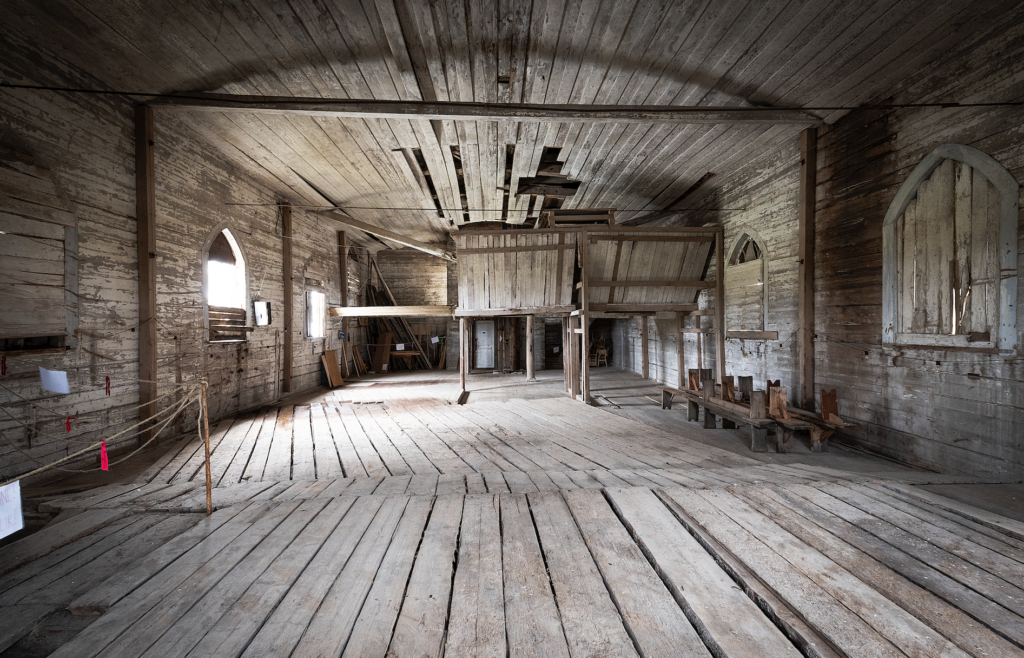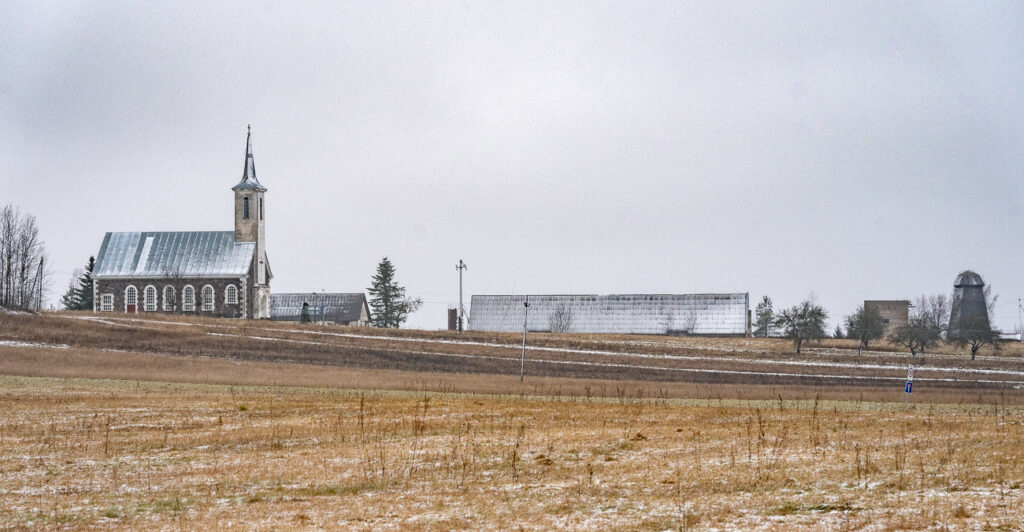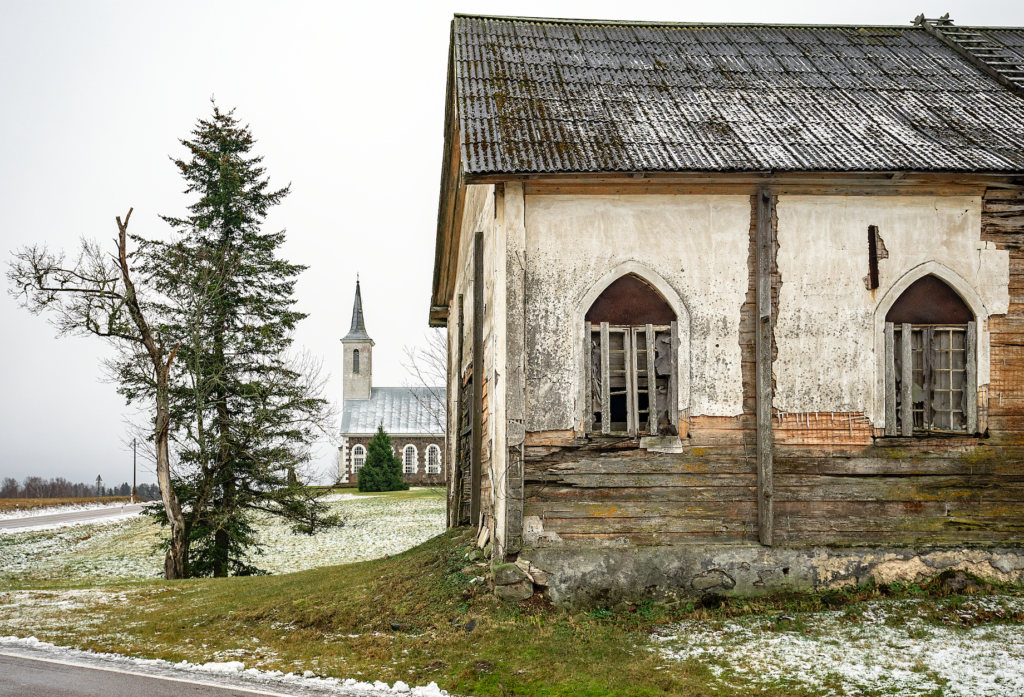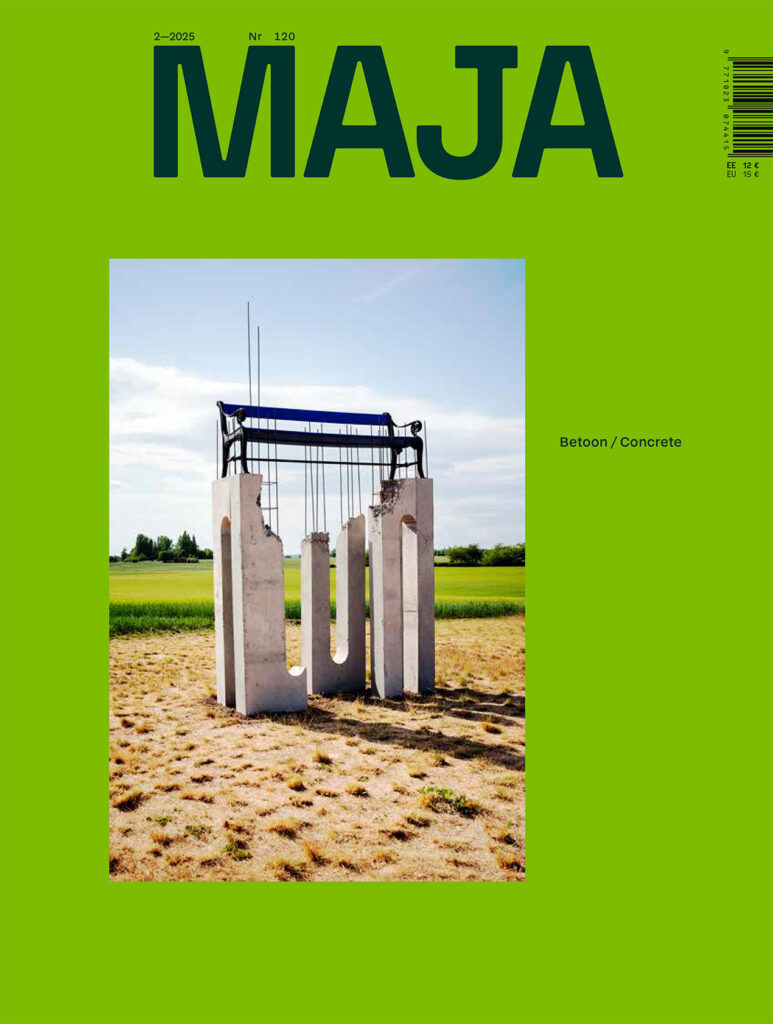TUDULINNA
1766: It is decided to build a wooden church on the wooded hill near Tudulinna village with 250 inhabitants out of the logs felled on site.
1864: There are 700 inhabitants in Tudulinna. The church is extended.
1895: A Dutch-style windmill is built on the hillfort.
1939: The congregation has split and the more rebellious members build their own church only 150 metres from the old church. As a sign of protest, the tower is set on the other side of the church.
1947: The old church is closed and soon turned into a gristmill.
1961: The tower of the old church is torn down.
1970s: The windmill loses its wings, also the electricity-powered work is discontinued.
2017: NGO Tudulinna Kultuurikants is established, the old church is cleaned up.
2019: The restoration project for the old church is completed.
The reconstruction of buildings under heritage protection and providing them with new content is one way to make a small borough known and alive again.
My story with Tudulinna begins in late 1980s on a bus rocking on the bends of a dusty gravel road. For a moment, a slender stone church, plywood grain dryer and the walls of crumbling plaster flash past the dusty window. According to my grandmother, the latter building used to be a church. During the collective farm days, the tower had been taken down and the building turned into a storage. Our relative uncle Juhannes used to have a large farm and a windmill in the “town”.
Over the years, Tudulinna kept getting more and more on my way to the country. After the workshop on the revival of Rapla KEK building with the Dutch group Failed Architecture during the Tallinn Architecture Biennale in 2013, there has been increased interest in recreating and conceptualising forgotten heritage buildings. It just so happened that the daughter of the self-same uncle Juhannes Heljo Tatsi was looking for someone to help to retain the wooden windmill across the road from the two churches of Tudulinna. She had already managed to renew the shingle roof of the Dutch-type wooden windmill that was part of their farmstead and taken under heritage protection at the beginning of the century as a well-preserved windmill quite unique to East Estonia.
If in Rapla, the octagonal KEK building designed by Toomas Rein was more or less in the town centre and gradually fell into oblivion during the independent years, then the old church and windmill in Tudulinna tended to remain as invisible industrial buildings despite their central location on either side of Peipsi-Rakvere road as the windmill lacked wings and the old church a tower. To me, the given border area next to the former hillfort with its three monuments represented the hub of (construction) history with the old church and windmill standing as the most important symbolic buildings of the past few hundred years. The new church completed in 1939 takes the passers-by immediately to the Functionalist apartment buildings and villas in Tallinn as soon as they hear the name of the architect Eugen Sacharias responsible for the buildings along the main streets in the capital. That’s why I thought that taking care of Tudulinna windmill was a good opportunity to revive a small corner in an Estonian borough to give voice to the history of Alutaguse area in a wider context.
Creating values in small towns
The discussions of the future of Estonian towns and small boroughs at the moment focus on dignified shrinking as there is little hope for growth. The Estonian exposition at the Venice Architecture Biennale in 2020 explores the future of small boroughs. One of the curators of the Estonian exposition, Valga town architect Jiri Tintera claims in the urbanists’ review U as follows, “When planning for [..] future, one has to learn how to adapt to the effects of population decline, and this means accepting the phenomenon of decline. /../It is easy to become bitter and this does not help with adapting to the new situation.” According to him, people in Valga still remember how the town flourished 30 years ago and they are increasingly disappointed in its decline in the past years as there has been nothing to be happy about or proud of.
Differently from the shrinking repurposing implemented in Valga to add value to the urban space, my task with the windmill was to find opportunities that in synergy with the nearby churches under heritage protection could add something to the borough. Tudulinna and Alutaguse have a rich history with their heyday more than 40 years ago. As we are losing our daily connections with such distant times and people, they can easily become folktales that are difficult to imagine without any firm anchors.
My research on the local history quickly led me to the conclusion that the old church and windmill of Tudulinna are not just single remnants but the representatives of the numerous churches and windmills of the nearby parishes that would function well as the anchors for fading memories. In addition to the physical and spatial activities, I also consider it important to bring the monuments to the local people’s consciousness. I find the project Pärandivaderid (Heritage Guardians) highly useful as it brought the school children of Tudulinna and Iisaku together to maintain the surroundings of the church and the windmill.
In 2016, Lauri Väinmaa began the old church restoration project by establishing the NGO Tudulinna Kultuurikants to bring together the local active people. Thanks to the cooperation with Lauri and the new church managed by the Estonian Evangelical Lutheran Church, we were able to create a new spatial core between the three buildings, and in the 100th anniversary year of the Republic of Estonia in 2018, we were supported by the National Foundation of Civic Society to erect an information board describing the three historic buildings in Tudulinna. It was a clear physical step taken to revitalize the so-called forgotten industrial backwoods of Tudulinna that will bring the former focal points of local life back to their current everyday routine and establish links with the follow-up activities envisioned in the new plans towards the hillfort. So far, the area seemed to be only a wasteland among the storage buildings as the windmill lacked the wings and the old church the tower. But now there is a space between them to introduce the area and provide the basis for getting to know Tudulinna. Considering the fact that the windmill and churches are located in the narrowest part of the road connecting the North-Estonian coast and Lake Peipus, the new informational space gives new reasons to stay at Tudulinna.
From the revival of a single building to creating a wider whole
The owners of protected buildings have gradually gained more public attention. The National Heritage Board and local governments work hard to support the guardians of buildings that are deemed valuable. My main goal was to give the windmill back its most characteristic feature – its wings – and create an exposition introducing the industrial heritage of Alutaguse that would lead visitors also to other interesting places (Peressaare homestead settlement, Järuska bridge, woodwork traditions in Iisaku and Avinurme etc). After years of applying for funding for the restoration of the windmill and preparing the special conditions, it became clear that it was important to develop the heritage buildings in Tudulinna together as a comprehensive whole and by the local government or the local people.
As by that time my life had taken me away from Alutaguse, I decided after long consideration to give the windmill of Tudulinna to the state. Considering that also the old church is owned by the local government, I find it the best way to ensure its preservation and the coherent development of the “heritage corner of Tudulinna”. I hope that its present owner, the Ministry of Finance, and the guardian of its heritage, the National Heritage Board, can cooperate with the local activists to continue featuring the windmill’s story. Perhaps the given example will also provide a good basis for new cooperation models for preserving valuable buildings.

KAUR SARV is a graduate of Urban Studies of EAA who has worked on the issues of repurposing architectural monuments at Linnalabor. He managed the windmill of Tudulinna in 2015-2019.
Comment

LAURI VÄINMAA is a pianist and initiator of the reconstruction of Tudulinna wooden church
In 1766, a church was built for the 250 inhabitants of the village of Tudulinna. A hundred years later, the village flourished with their own brass band and choirs. They soon staged plays and operettas, there were almost 150 students in the local school. The development was followed by the Soviet occupation – within 50 years, almost all the achievements were lost with only derelict buildings left on the hillfort.
My childhood summers were spent in my family farmstead 6 kilometres from Tudulinna. When driving through the borough, children were always shown the new and the old church with many accompanying stories. There were lorries with grain driving into the old church. There came a time later in the 1990s when the old church remained empty, with its doors wide open and only rubbish inside. The village of Tudulinna was gradually running empty, there were rumours about closing down the school.
In the summer of 2017, I had an epiphany as if by lightning, “What if we saved this church!” The bolt of lightning had been prepared by all the previous years, my entire life before it. And this was the beginning of the NGO Tudulinna Kultuurikants.
As we are looking back now two and a half years later, we can state that the most important achievement was the completion of the restoration project in 2019. It is the fifth oldest surviving wooden church in Estonia, national architectural monument. Our wish is to turn it into a venue for concerts, plays and other cultural events. Already in its present condition, the building has a unique and strong aura. Words and music carry a very special sound there with the church’s proportions and 250-year-old timber walls providing it with excellent acoustics. According to the local legend, the old church was constructed on a sacred site much like in many other places in Estonia. All this gives all the more reason to restore the church and give it back to the people as a place of mental and spiritual cleansing. What would work better to this end than listening and playing music?
As of today, there have been two summer festivals “Tudulinna tuled” with many other events. The church is tidy, with its doors closed and the surroundings maintained. All this has brought new life to the hillfort of Tudulinna forming the basis for the cultural centre of the village. We can be very proud and happy to have a church hill with a wooden church from the 18th century, windmill from the 19th century and a stone church from the 20th century.
It is important to have a vision: the sun shining through the old church windows on a lovely hillside with the old windmill and slightly younger church nearby and beautiful music in your ears…
HEADER photo by Johan Huimerind
PUBLISHED: Maja 99 (winter 2020) with main topic Rural Insights








